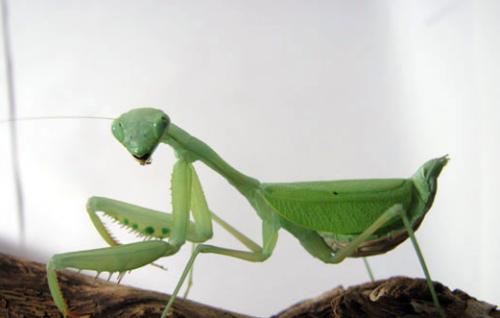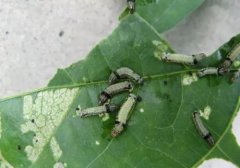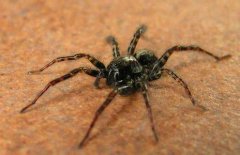Mantis breeding: can little praying mantis be raised by itself? How to raise mantis?
Using fruit flies to raise small mantis, have you heard of this method of raising mantis? If you want to learn this method of ecological farming, let's take a look at it together.
Predatory natural enemies belong to a part of the predatory food chain, such as mantis catching cicadas, yellow finches behind, the relationship between the three, forming the food chain. Each kind of natural enemy has its natural enemies, such as mantis from egg to adult, there are natural enemies in every period, there are parasitic wasps, ants, bark beetles and so on in egg stage, while nymphs and adults have birds and nematodes. Mantis is a predatory natural enemy, can prey on aphids, flies, locusts, moths and other pests, newly hatched nymphs are small, about 0.6-0.8 cm, at this time the supply of prey, should be the same or smaller as nymphs, such as aphids, fruit flies, nymphs can catch prey. However, when the praying mantis is larger, it eats more food, and the larger the bait it provides, the more it should eat.

There are small insects such as aphids or fruit flies in the prey of mantis larvae. Aphids can be found everywhere on wild plants and field fruits and vegetables, and there are many kinds of them, but when mantis feeds, it can hunt regardless of aphids. Although aphids can be propagated indoors, it is not easy to control the number of aphids, and if the protective measures are not done well, it is easy to cause secondary harm; on the contrary, the reproduction method of fruit fly is simple, and its adults can be propagated by ripe melons and fruits or rotten plants, and can also be propagated in large quantities with artificial feed.
The formula and steps of artificial feed are as follows: first, add 5 grams of cabbage powder, add 2 liters of water to boil, add 120 grams of yeast powder and 140 grams of brown sugar, and stir continuously after adding. Another 300 grams of corn meal must be dissolved in 1 liter of cold water before it can be added, otherwise it is easy to form lumps and not easy to dissolve. When the dissolved cornmeal is added, keep stirring to avoid sticking pot, turn off the heat and wait for cold as soon as it boils, the temperature drops to about 80 ℃, pour 18ml alcohol into stirring, then pour in 18ml propionic acid to stir, then use deep bottom plastic plate (so that it does not need frequent replacement and additional artificial feed) sub-packing. Each plate is about half full, otherwise, the fruit fly will crawl around the plastic plate to pupate everywhere, and cotton can also be placed on the plate and on the four sides of the plate for habitat and pupation. When the artificial feed temperature drops to room temperature, it can be put into the insect box. If the reproduction number of fruit flies is large, the iron frame can be used as the skeleton, and then the iron frame can be used to surround the iron frame with a screen mesh of 32 mesh, and then introduced from the field, and the artificial feed can be put into the feeding box with a plate of artificial feed, and the temperature can be controlled at about 27030 ℃. However, special attention should be paid to the introduction of fruit flies from the wild, sometimes parasitoids of fruit flies are introduced at the same time, making it difficult for fruit flies to reproduce.
When making use of natural enemies, a large number is often needed to quickly control pests below the level of economic harm, but it is not easy to reproduce a large number of substitute food for natural enemies. The breeding process of fruit fly is simple, the space needed for breeding is small, the cost is very low, and its life history is short, about 10 to 12 days from egg to adult, so it is easy to reproduce in large numbers, so fruit fly is a very good substitute food for breeding mantis.
- Prev

What are the natural enemies of insects? What are the natural enemies of insects? lacewings.
What are the natural enemy insects, what characteristics do they have, and what do they mainly eat? using natural enemy insects to control pests is a special control method, which can reduce environmental pollution and maintain ecological balance. Remarkable achievements have been made in the propagation and utilization of natural enemy insects in China.
- Next

How to control mites scientifically? What are the control methods of mite pests?
What do you know about the application of predatory mites in agricultural pests? What are the characteristics of predatory mites in agricultural pests? If you want to know, let's take a look. Biological control emphasizes the use of predatory natural enemies to control pests.
Related
- A one-day flower show brings 130 million yuan in orders! Nanhai, this Phalaenopsis exhibition is amazing
- What do the flower language and meaning of Lutheran tree mean? Precautions for planting Lutheran tree
- Encounter Chaoshan Kongfu tea, not without this cup of Phoenix single clump
- The durian market in Vietnam and Thailand is flooded. The price of imported durian has plummeted by 30-40% in a month.
- Shanghai solved the problem of local vegetable supply by planting 80,000 mu of green leafy vegetables.
- Wageningen University has become the best agricultural university in the world for the seventh time in a row.
- The strongest export season of South African grapes is full of challenges, with exports to Russia falling sharply by 21%.
- Sri Lanka is on the verge of bankruptcy, "Tea for debt" Organic Agriculture Revolution aggravates the Food crisis?
- Turning waste into earthworm manure and worm manure into organic fertilizer-A new choice for auxiliary farming
- Organic rice growers shoulder the responsibility of nurturing agricultural talents! Yinchuan Sustainable Farm with Organic Life Camp

